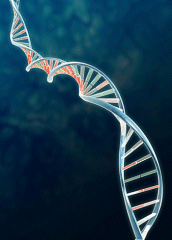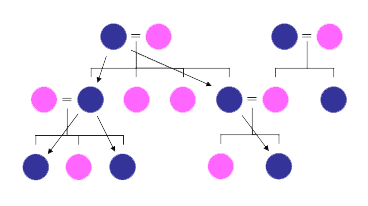DNA in Family History
Introduction
In recent years, but in particular during the last ten years, the
study of DNA and genetics has becoming increasingly significant for family
historians. Within each cell of our body we possess genetic markers handed down
from our natural father and mother. These markers contain the code that form the
basis of cell production and the way in which we inherit our parents
characteristics.

A chromosome
![]() is a package of genes and DNA material in the nucleus of a cell. There are 46
human chromosomes which exist as 23 pairs, the last pair being the 'sex'
chromosomes; known as 'X' or 'Y' chromosomes. In this last pair a child receives
one chromosome each from its father and mother. A man will have a YX pair
and a woman a XX pair, each chromosome coming from
the father and mother respectively. Hence a man receives a Y chromosome
from his father and an X from his mother while a woman receives a X chromosome
each from her father and mother.
is a package of genes and DNA material in the nucleus of a cell. There are 46
human chromosomes which exist as 23 pairs, the last pair being the 'sex'
chromosomes; known as 'X' or 'Y' chromosomes. In this last pair a child receives
one chromosome each from its father and mother. A man will have a YX pair
and a woman a XX pair, each chromosome coming from
the father and mother respectively. Hence a man receives a Y chromosome
from his father and an X from his mother while a woman receives a X chromosome
each from her father and mother.
Each chromosome is made up of many, many miles of DNA material which contains genetic code, or instructions, for the making of life. A DNA molecule is made of two separate strands twisted in the shape of a double-helix, or spiral. Sections of this DNA contain the heredity genes which are passed from parent to child and create many of those 'family characteristics'. The DNA also carries within it 'markers'. These markers are minute variations in the structure of the DNA which can be used to track inheritance in families.
Parental Indicators
As the Y chromosome is handed down from father to son in continual
secession and our culture passes surname from father to child, this could be
considered as a 'surname marker'. For example, the great great grandsons of
their direct male paternal ancestor will all have the same Y chromosome.

Family Connections
The Y chromosome therefore may be seen as a marker with significant implications for
finding family connections. Where two families with the same surname appear to have a
possible link (e.g. they originate in the same geographical location) but a paper trail
connection cannot be easily found, a DNA test will indicate a strong possibility as to
whether or not that connection exists.
Note the phrase - 'a strong possibility'. DNA contains many such inheritance markers and the certainty of connection will depend on the number of markers being checked. A DNA test on two people with the same surname showing an exact match on a certain number of markers indicates a very high probability of common ancestor but it cannot prove a direct link. The chances may be extremely high but cannot be proven. The possibility of a common ancestor will also increase with a larger number of (agreeing) test markers.
Y-DNA Testing Testing an individual's DNA is now assisting genealogists in finding potential family connections. In particular, one name studies such as the one presented at this site, are beginning to use DNA testing as an extra tool in their research either showing or discounting possible links between people from hitherto unconnected groups having the same surname.
You will find a Rowden DNA project at
Family Tree DNA
![]() for which I am the project coordinator. If you are a male Rowd*n then I encourage you to join the project.
"The prime goal of the project is to identify and unite Rowden family
members with their respective DNA matches; to discover the potential links
between the many known groups of Rowdens which have been found by paper trail
research. From these links it is hoped that we will discover more about the
origins of this surname."
for which I am the project coordinator. If you are a male Rowd*n then I encourage you to join the project.
"The prime goal of the project is to identify and unite Rowden family
members with their respective DNA matches; to discover the potential links
between the many known groups of Rowdens which have been found by paper trail
research. From these links it is hoped that we will discover more about the
origins of this surname."
- Join the

- Go to the to discover what we've found.
- Follow the FTDNA link above to learn more about this useful and exciting development.
Useful Web Links
Family Tree DNA
![]() - FamilyHistory and DNA Research site.
- FamilyHistory and DNA Research site.
DNA Resources
![]() - by the Family History Federation.
- by the Family History Federation.
National Human Genome Research
![]() - a very useful for a glossary for detailed explanations.
- a very useful for a glossary for detailed explanations.


